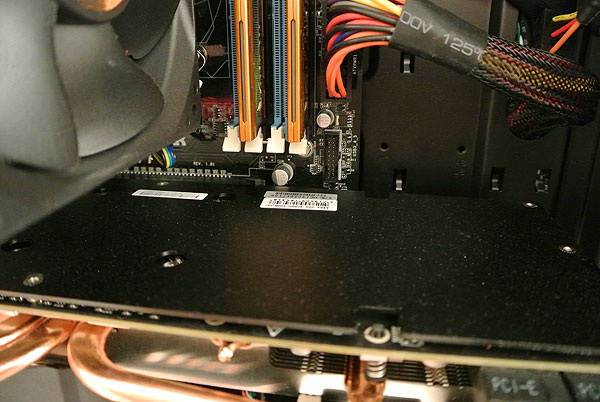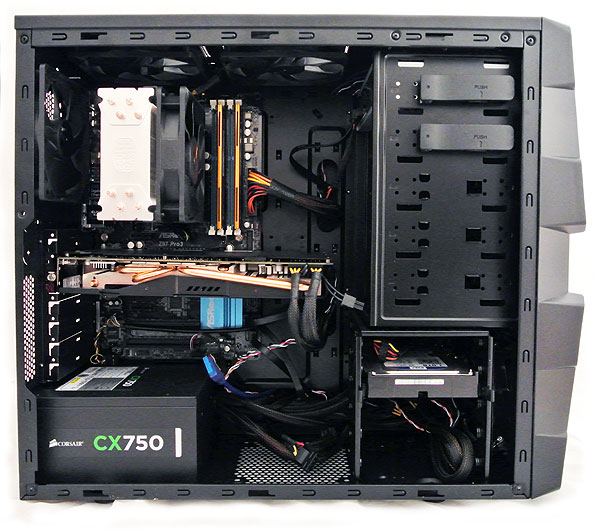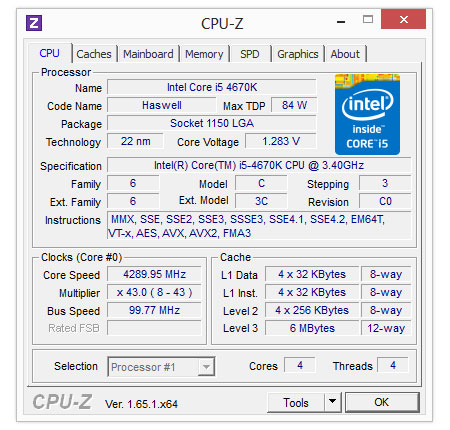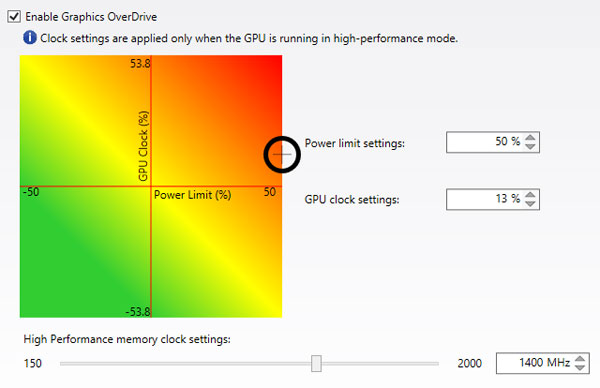System Builder Marathon, Q2 2014: Our Enthusiast PC
Building And Overclocking Our Mainstream Enthusiast System
While the build went smoothly, I did encounter a handful of minor irritations. For instance, Apevia's X-Hermes surprised me with its excellent fit and finish. However, Cooler Master's large Hyper 212 Plus interfered with the case window's 200 mm fan. As a result, I had to remove that and sacrifice some of the enclosure's airflow. In addition, I was surprised to find that the ASRock Z97 Pro3 motherboard's internal USB 3.0 header is uncomfortably close to the top PCI Express slot. Normally, this probably wouldn't cause a problem. But because PowerColor adds a back plate to its card, occupying space it shouldn't, the USB 3.0 cable end presses hard against the Radeon R9 290. I unplugged the front-panel header and used the USB 2.0 interface on the bottom of the board instead.
Once everything was plugged in, the PC fired up without incident and software installation went smoothly. As you can see from the picture below, the case comes equipped with some cable management concessions, and ASRock's smaller board is dwarfed inside.
Overclocking
I can't remember how many Core i5-4670K processors I've tuned at this point, but the number is large. While I often boot successfully at 4.5 GHz, stability issues in taxing workloads almost always push me down into the 4.3 GHz range. This time is no different. A final overclock to 4.3 GHz is fed by a 1.285 V setting in the BIOS.
Left to its own devices, ASRock's board set my Team Group memory kit at 666 MHz, 9-9-9-24-1T timings. That's where I benchmarked it for the stock run through our test suite. Then, I invoked the XMP memory profile and ran the kit at 800 MHz with 9-9-9-24-2T timings for our tweaked results.
ASRock's Z97 Pro3 facilitates overclocking options and performance similar to boards that are significantly more expensive. The following CPU-Z screenshot illustrates our modified configuration:
I used AMD's Catalyst Control Center interface to overclock PowerColor's card. The TurboDuo board comes factory-tuned with a 975 MHz maximum clock rate. However, a power limit increase to the peak 50% settings allowed me to crank the core up 13% more. FurMark reported a corresponding 1100 MHz frequency under load.
Get Tom's Hardware's best news and in-depth reviews, straight to your inbox.
The memory wouldn't cooperate at 1500 MHz, so I dropped it back to 1400 MHz. That's still significantly higher than the stock 1250 MHz setting.
Current page: Building And Overclocking Our Mainstream Enthusiast System
Prev Page Memory, Hard Drives, And Optical Storage Next Page How We Tested Our Mainstream Enthusiast SystemDon Woligroski was a former senior hardware editor for Tom's Hardware. He has covered a wide range of PC hardware topics, including CPUs, GPUs, system building, and emerging technologies.
-
BilinearCheese I have to say guys, that enthusiast level build is terrible. Apevia case? Turbo Duo 290? NO SSD? Come on. For 16 bucks less I put together a system WITH an SSD, a decent case, a much better 290, and a better motherboard/cpu cooler. Hell, I even managed to get a color scheme together for it as well:Reply
http://pcpartpicker.com/p/FRyNgs
"Terrible" = same CPU, cooler, graphics card, and equal benchmark performance?
The case we chose really doesn't matter, as the first page of article points out. Case/optical drive is completely subjective. That's exactly why we've separated the performance parts price from case/optical/OS.
By the way, are you just assuming Apevia its bad because you prefer other well-known brands? It did a fantastic job for the purposes of this article, so other than brand, what's your issue with it? Is brand the same problem you have with the 290? Because it's cooler is quite good.
Speaking of coolers, the Hyper 212 EVO is virtually the 212 plus with a different fan. Is this really the huge difference you're implying it is?
You're also specing it out two months after we did, with lower prices. An SSD would have been great, but two months ago when we ordered there was no room in the budget, and we weren't willing to sacrifice the 290.
Bottom line, you're being a little sensationalist about picking nits. -
itzsnypah When overclocking the CPU are you leaving the uncore coupled to the core multiplier or uncoupled and set at x34/36? You averaging nearly 1.3v for only 4.3Ghz is very poor.Reply -
I have to question the need for Z97 mobo. If you go with the Haswell and not the Haswell update and you do not include M.2 SSD, then why go with Z97? If you are choosing the Z97 to have a upgrade path, you should also go for the Devil's Canyon cpu. Budget-wise it is a really bad idea to even think about going for D.C. Haswell chip later on.Reply
The ssd gives you an easily felt sensation of speed every time you boot. Just got an ssd myself like 2 months ago. Any other go-fast parts come secondary. Ditch the Z97 and the ODD and you could squeeze in a SSD. -
envy14tpe @BilinearCheese. I believe all parts for these toms' builds have to be from Newegg. So, try building that way.Reply -
BilinearCheese Reply@BilinearCheese. I believe all parts for these toms' builds have to be from Newegg. So, try building that way.
How is this the best suggested build for the money if you're only locking it to one retailer? That's...kinda silly
-
Crashman Reply
Because if we get all our parts from Newegg, it's Newegg's money? Because, when Newegg pays for the parts, we can afford to give the entire systems away?@BilinearCheese. I believe all parts for these toms' builds have to be from Newegg. So, try building that way.
How is this the best suggested build for the money if you're only locking it to one retailer? That's...kinda silly
:p
-
envy14tpe ReplyBecause if we get all our parts from Newegg, it's Newegg's money? Because, when Newegg pays for the parts, we can afford to give the entire systems away?
:p
No one will ever question your parts selection ever again!! Maybe add a side note on price page that all parts are from/ must be bought on Newegg. -
BilinearCheese ReplyBecause if we get all our parts from Newegg, it's Newegg's money? Because, when Newegg pays for the parts, we can afford to give the entire systems away?
:p
All newegg, still cheaper with better components:
http://pcpartpicker.com/p/pj7bCJ
What's the next rule, no rebates? -
Crashman ReplyAll newegg, still cheaper with better components:
http://pcpartpicker.com/p/pj7bCJ
What's the next rule, no rebates?
No mail-in rebates because they usually disappear before we can publish and, because when you have $100 you can't buy a $149 part that has a $50 MIR :)
Instant rebates and sales are fine because when the discount on one part disappears, the discount on another part appears.
BTW, I like the look of your case. I never understood what the deal was with don and ugly cases, but he's Canadian so I know better than to ask. -
BilinearCheese ReplyNo mail-in rebates because they usually disappear before we can publish and, because when you have $100 you can't buy a $149 part that has a $50 MIR :)
Instant rebates and sales are fine because when the discount on one part disappears, the discount on another part appears.
Even with that in mind, my second build without rebates totals 1178. Changing the motherboard to a z87 Extreme3 (because z97 isn't a benefit if you're not going for haswell refresh or an ssd) and it's 3 bucks more than the build listed.




